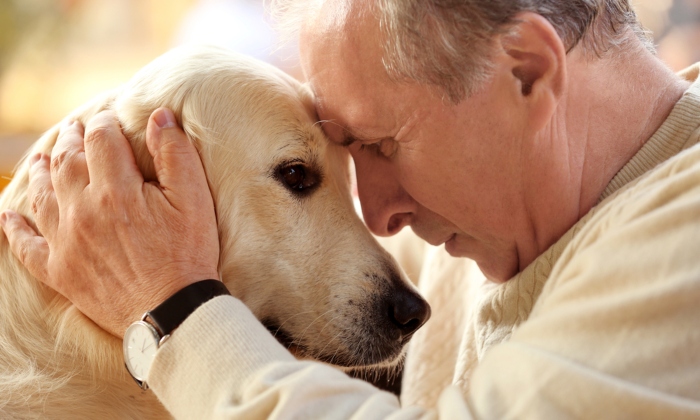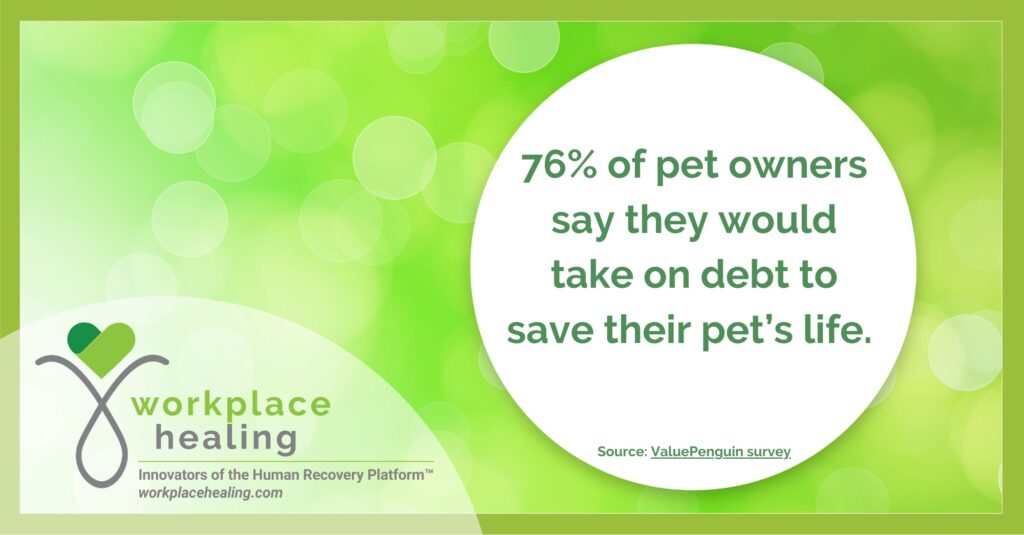
Must Love Pets: How to Retain & Re-Engage Employees Coping with Pet Grief
Plus, get an inside look at a Human Recovery Plan® we built for an employee grieving the loss of a beloved pet.
We are a nation that loves our pets and establishing a pet-friendly work environment is increasingly important to employee retention and engagement.
While that doesn’t mean you must allow pets in the office (although that’s a nice perk for many employees), pet insurance, pet bereavement leave, “paw-ternity” leave, and pet caregiving & grief Human Recovery Plans are some of the innovative ways companies are sweetening their employee benefits packages to retain valued employees.
A Nationwide survey found that nearly half of employees, particularly Gen Z and Millennials, say they are more likely to stay with an employer that offers pet benefits. And, more than 91% of employees who work at a pet-friendly company feel more engaged at work versus 65% who don’t.
Ongoing stigma around pet bereavement.
When a pet is sick or has died, many employees feel they must hide their grief because they fear appearing too sentimental in front of their supervisor or worry that there’s something wrong with them for caring so deeply about their furry or feathered friend.
Without the right leadership support, the emotional and financial stress of caring for a sick pet or coping with the death of a beloved animal companion can affect an employee’s productivity, focus, and engagement.

Why is the death of a pet so hard?
Our pets provide unconditional love, companionship, joy and often a sense of security. Studies find that pets help reduce stress and blood pressure and ease symptoms of anxiety and depression. Often, they keep us physically and socially active and give us a sense of purpose as we attend to their needs, including when they are sick.
According to Kent State University, 85% of pet owners consider their pets members of their families. From dogs and cats to horses, birds and reptiles, Americans spend $124 billion each year on pet care, services and products. Owners of service dogs, spend up to $50,000 upfront and as much as $10,000 each year on their dogs.
It’s no surprise that for many people, the death of a beloved pet or support animal can be as disruptive and challenging as experiencing the death of a human loved one—sometimes more so.
“There’s a huge gap when a pet is no longer in your life,” says Tammy Carley, Workplace Healing Client & Partner Success Manager.

When Tammy’s dog Tanner, a 16-1/2-year-old cockapoo, died in August, a month before the one-year anniversary of her mother’s death, she was devastated.
“When I was trying to have children, I kept having miscarriages and ultimately was not able to have any children of my own. Tanner filled that void of not having a child,” Tammy says. “Working from home, he would always be in my office. Now, he’s not here anymore and that’s hard. He was my little shadow.”
Helping an employee cope with losing a pet.
Our easy-to-build Human Recovery Plans feature a balance of practical and thoughtful ideas to support employees who are caring for a sick pet or grieving the death of their pet. Here’s an inside look at the plan we created for Tammy:
- Immediately granted Tammy’s request for time off.
- Mailed a condolence card and arranged for a flower delivery.
- Received a meal kit voucher from a local meal delivery company.
- Continued to check in on her regularly.
“I received more acknowledgment from Workplace Healing when Tanner died than I did from my previous employer after my mother died,” Tammy says.
What not to say.
You can always get another one. Getting another pet doesn’t replace the one an employee lost or make the loss any less difficult. “Maybe to you, it’s just a dog or cat. But to an employee who’s going through it, it’s not just a dog or cat, it’s a member of their family, it’s their “fur baby,” Tammy says.
Don’t cry. Telling someone to suppress their feelings can feel dismissive, cause shame or embarrassment and prolong the grieving process.
S/he lived a long life. Just as with a human loved one, a pet’s longevity doesn’t make their death any less difficult.
Your pet is in a better place now. The only place a griever wants their pet is in their home and by their side.
When my pet died…[give specifics about what you did and how you reacted to the event]. Although people often say this to show they can relate, these stories can invite comparisons in a griever’s mind. They may question if they should have done something differently or wonder if they should have had a similar emotional reaction, adding to the guilt they may already be feeling.
What to do and say instead.
Listen. Ask empathetic questions and use their pet’s name. For example: “What was Whiskers like?”
Be flexible. If your employee needs time off to take their sick pet to vet appointments, give medications over their lunch hour or spend time with their family after a pet’s death, offer flexibility in their schedule.
Express understanding. If you’ve also suffered the loss of a beloved pet, let your employee know that you understand how challenging it can be, and ask how you can support them.
Offer meaningful support resources. Provide a list of online pet caregivers or grief support resources like the Association for Pet Loss and Bereavement. Counseling can also be beneficial for anyone feeling “stuck” in the grief process or who experienced a pet’s traumatic injury or sudden death.
Your solution to retain valuable employees. Employee life disruptions are inevitable, and your response is crucial to retention, engagement and productivity.
Our innovative, easy-to-use Human Recovery Platform™ provides you with on-demand tools and resources to build a balanced, thoughtful and strategic plan that supports employees through life disruptions like:
- Death of a loved one, including pets
- Caregiving
- Divorce
- Personal injury and illness
Schedule a free demo today!


